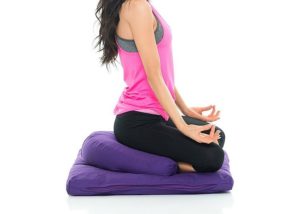There is no doubt that meditation is good for you. Knowing that is the easy part, but how do you do it, and where do you start? If you’re new to meditation, it can be a bit overwhelming. The thought of sitting in complete silence and “thinking of thing”, can be daunting. Not to worry, learning how to meditate doesn’t have to be a challenge, we’re here to help. With our rundown of the five best meditation techniques for beginners.

The Benefits Of Meditation
Ask anyone who’s been meditating for years what they like about it and they’ll most likely, tell you that it’s the number one thing they can count on to feel good.
Here are just a few of the proven benefits:
- Regulates and balances your mood, improving happiness and lowering, stress, anxiety and depression.
- Encourages, deeper and more restful nights sleep.
- Builds connection and intuition to yourself and the divine.
- Increased sense of love and compassion for yourself and others.
- Improved circulatory and cardiovascular system
- The ability quiet negative “mind chatter” aka the “monkey mind” (1) so you can tap into a deep feeling of inner peace.
- Improved focus (2), memory and cognitive recall.
- Slows down the aging process
- Enhances the immune (3) system, supports and improves mental, emotional and physical healing.
- And many, many others!

Meditation Helps You Discover The Present Moment
Would you like to feel greater clarity, less worry and an improved sense of wellbeing? This is found in the present moment. When you meditate, you are essentially using an age old technique to clear your mind. A technique that allows you to let go and feel more present and peaceful.
Meditation helps to quiet the mind, cultivate inner peace and boost energy. It helps you to develop your sense of compassion, love and forgiveness. You stop worrying about the past or the future and become more peaceful with what is. Able to live more in the moment.
Meditation can be done anywhere, any time and in any form. Your eyes can be closed or open, you can be sitting, standing, walking or lying down. You can be listening to music or a guided meditation. You can meditate with chant, mantra or mala beads in your practice.
Everyone can do it and anyone can reap benefits from it.
The Main Groups of Meditation Techniques
Focused-attention Meditation Technique
In a focused-attention meditation, you concentrate your attention on a single object, thought, sound or visualization. You may direct your focus on an object, breathing, a word or a phrase, a guides voice or simply pay attention to the present moment.
If you’re like most beginners, this method can feel easier, than trying to completely clear your mind or focus on nothing at all. For more on what you should think about and focus on during meditation read our in depth article here.
Open-monitoring Meditation Technique
The Open monitoring meditation style, is often used by more experienced meditators (though anyone can do it). This style builds upon the foundation of attention previously cultivated in a focused-attention practice.
This style encourages awareness and all aspects of your thoughts, body and environment. Including, the process of not reacting to or following your train of thoughts.
“Feelings come and go like clouds in a windy sky. Conscious breathing is my anchor.” – Thich Nhat Hanh

How to Choose the Right Meditation Technique For Beginners
First let’s just get clear, there is no right choice or wrong choice that you can make here. It’s important to do what works for you and try whichever method you are most drawn to that seems like a good fit. We strongly encourage you to be open, and curious about your choice.
When you are open, you don’t get bogged down by trying to make something work for you, that is just not right. Having this type of awareness, can help push you past any roadblocks you might have when first starting out.
Remember, that anything new to you, is going to feel a little bit awkward and out of your comfort zone at first. Thats completely normal, just give it a bit of time.
You may find that you experience benefits within a few days, but keep in mind that the biggest benefits will develop over time. What’s most important though, is that you stay consistent and don’t give up!
How Long To Meditate For Beginners
You can start with just two minutes, and work your way up from there. It will seem easy and that’s great start! Do it for a few days and if that goes well, increase it to 5 then 7, then 10 etc.
Experiment with what works best for you. You’ll find it easier the more you do it.
When you’re just starting out sitting still, even for a few minutes, can seem like forever so don’t put too much pressure on yourself. One of my all-time favorite quotes on learning how to meditate is from master teacher, Jack Kornfield, author of Meditation for Beginners and A Path With Heart, (also found on our list of best meditation books for practitioners of every level) is:
To steady and focus the mind takes kindness and patience. Monitoring your thoughts is like training a puppy. You say ‘stay’ but after a few breaths, the puppy wanders away. You go back and gently pick it up and bring it back.” – Jack Cornfield
There is no rush, be kind and compassionate with yourself, with daily practice, you will get there. There are also many helpful tools like headphones, that can support you as you strengthen your practice. If you want to learn more, read our guide to the best meditation cushion sets here.
When You Should Meditate
Meditation can be done anywhere, anytime! However you will need to set aside the time and space for it. Most beginners will find that making meditation part of their morning routine to be the easiest way to keep a daily practice. For a list of inspiring morning guided meditations perfect for beginners check out our article here.
5 Easy Meditation Techniques For Beginners
1. Mindful Breathing Meditation
This is one of the most popular forms of meditation and is one of the easiest meditation techniques for beginners to learn. This is also usually the first type of meditation I suggest to someone just starting their practice.
At its core, mindfulness is all about exploring the ability to be fully present. Aware of where you are and what you’re doing. Observing, over reacting to what is going on around you at any given time.
Simply put, you’re just noticing, you aren’t trying to get anywhere. You’re not trying to do anything. Mindfulness (4) is bringing a non-judgemental awareness to what you’re currently experiencing through your senses, your mind, your thoughts and emotions.
Mindfulness is fluid and can be anything that you want to bring awareness and presence to. It can be practiced walking, breathing, eating or anything that is body or senses related.
When done regularly and with focus this can be a deeply, healing and nourishing form of meditation.
As it lets you just simply be.
How To Start Your Mindfulness Meditation
1. Set aside some time and space in your day. You don’t need any sort of special equipment to access mindfulness skills—but you do need to set aside some time for your practice. You can do it anytime of day however, many people find first thing in the morning ideal.
2. Find a quiet place where you won’t be disturbed or will have the least possible distractions.
3. Next, find a comfortable sitting position that is stable, solid and comfortable. You can sit on a chair, cushion or meditation bench, but try to sit up straight and maintain that alignment without being super rigid about it.
If you’re using a cushion, cross your legs comfortably in front of you. If you’re on a chair, sit towards the edge so the bottoms of your feet are on the floor.
4. Breath in and out deeply through your nose. Gently let your eyes close, your shoulders relax and your arms soften.
5. Become present in the moment. Become aware of your breath and observe the present moment, as it is. Don’t try to control your breathing or thoughts, just observe and let your body and mind calm naturally.
Remember that, the practice of mindfulness is not to completely empty your mind of thoughts or attempt to achieve a state of deep Zen. It’s simply to to pay attention to the present moment, and observe without judgment.
6. Acknowledge your thoughts and release any judgement. Know that things will come up, just note them then let them pass by. Understand that this is normal, don’t worry that you are doing anything wrong. Be kind to your wandering mind.
7. Keep returning to your breath. Mindfulness is the practice of returning, again and again to the present moment.
That’s it really! Mindfulness is basic and simple, though not necessarily easy when you first learn. This is why it’s called a practice. Which with continued use, you’ll find it getting easier within a week or two.

2. Walking Meditation
This is another In this easy meditation exercise for beginners, and is based on the principles of mindfulness and is simple to learn and do. This is good for beginners or for anyone who has trouble sitting calmly.
It can also be a bridge to a regular sitting meditation practice. With regular use, a walking meditation can give you a feeling of a deeper connection to the world, as you move through your day to day life.
- Just like described in the sitting meditation above, its best to start your walking meditation (5) in a quiet and peaceful time and place.
- Start out walking at a natural pace.
- Notice your breath, notice how your steps hit the ground.
- Feel your foot as hits the ground, feel it as it rolls up lifting your toes as you step.
- Tune in to your body and anytime your mind starts to wander redirect your thoughts to your breath and your steps.
3. Guided Meditations
Guided Meditations are another form of a focused style practice, and are a technique that’s become popular in recent years. There are several reasons for this.
First, a guided meditation is a great place for a beginner to start. Secondly, this technique also works well for anyone who struggles with anxiety, or is unable to sit still for more than a few minutes at a time.
A guided meditation can be led by another person, for example in a class, or through a recording or app. It’s easy to do, which is can be very helpful to keep a beginner motivated to stick with their new practice.
This is especially good if you want to make meditation a daily habit. It can be so easy to get off track!
Many guided meditations have a theme, which you can use for focusing on a specific outcome. Such as better sleep, healing, balancing your chakras, manifesting or finding one’s purpose in life.
If you’re curious about exploring a guided meditation practice, then check out this list from the Purpose Fairy.
 4. Loving-kindness (Metta) Meditation
4. Loving-kindness (Metta) Meditation
Loving kindness meditation also known as Metta was taught by the Buddha and is, in many ways, a spiritual path all in itself. It’s all about opening up the heart and cultivating the four qualities of love: friendliness (Metta), compassion (Karuna), appreciative joy (Mudita), and equanimity (Upekkha) for ourselves and others.
This is a foundational practice that the more you do it, will open up the world and connect you with other living beings in a way that few things can. Metta has also been been studied (6) extensively in regards to its many proven benefits.
How To Do Metta (Loving-Kindness) Meditation
Metta is easy to do and can be adjusted and adapted to your preferences. The general idea is, as you sit, you connect with your heart and send loving thoughts outward to yourself and others.
To do this, it’s suggested that you start with a repeating a mantra over and over. It can be helpful to first visualize a happy moment you’ve experienced. Then secondly, call up the loving feelings associated with that happy moment, before you begin.
A typical mantra a beginner might use is:
“May they be well. May they be happy.
May they be healthy. May they be at peace.
May they be free from pain and suffering.”
Get still, breathe open your heart and direct your love and good-will towards:
- First: yourself
- Second: Someone that has shown you caring or kindness
- Third: A friend or family member
- Fourth: Someone neutral, that you feel no feelings towards
- Fifth: A person you actively dislike
- Sixth: All beings alive on the planet
To Begin:
1. Get in a comfortable, position and breathe in and out deeply.
2. Create connection and hold the image of the person in your mind.
3. Get into your heart. Call up feelings of goodwill and love as you chant your mantra.
4. Send Out Love. Imagine sending those feelings outward, towards the person.
5. Transfer your feelings. Imagine, that love extending to the next person and so on.
The more frequently you practice metta, the more joy, happiness and connection you’ll feel on a regular basis.
 5. Binaural Beats Meditation
5. Binaural Beats Meditation
This style of meditation is a relatively new development and can be a helpful technique for the beginner to try. As it is designed to quickly, drop you into a deep meditative state. Just like chanting a mantra, this gives your mind something to relax and focus on.
Meditation works by slowing down the electrical impulses in your brain, allowing you to think clearer.
Binaural beats (7) are designed to help you achieve this by playing two slightly different frequencies of sound into each ear. These unique tones help your brain slow down by naturally matching the sounds it hears.
Once your brain slows down, you’re able to reach a meditative state deeper, faster and easier.
It’s important to note that binaural beats only work when played in stereo, you must wear headphones to get the benefits.
To read all about using headphones with meditation and why they so great, especially for beginners, read our article here.
At the end of the day…
No matter which method you choose, provided you pick and stick with the one that best fits you. You should be able to notice the benefits of a daily meditation practice within a short period of time.
We hope that these basic and easy meditation techniques for beginners support you on your journey to living a more mindful life. There’s no telling where your practice will take you. But there is no doubt about it, living a more peaceful life is a vital step towards you living a life of greater harmony. Not to mention greater peace, happiness and freedom.
Namaste!
You also might like:
9 Amazing Guided Mindfulness Meditations for beginners
21 of The best books on meditation for beginners & advanced Zen seekers
Seven best meditation cushion sets
Don’t forget to save this list of easy meditation techniques for beginners on Pinterest!








Comments are closed.